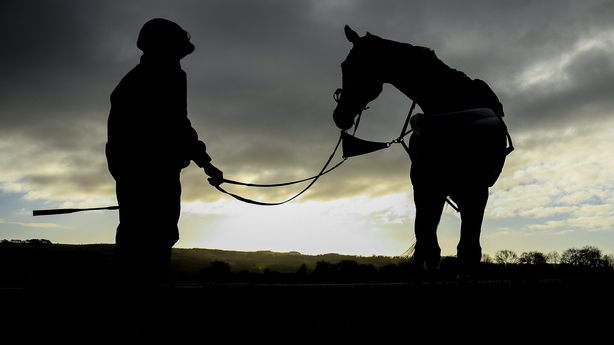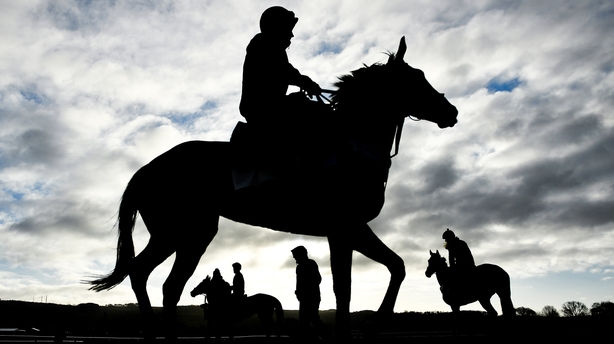Here are just some of the terms in the racing lexicon that we could hear this week as Cheltenham goes to post.
Accumulator
Multiple bet involving more than one selection where winnings roll over on to subsequent selections. All of the selections must win (or place, for each-way bets) for the bet to be successful.
Act on track
Horses often exhibit preferences for certain racecourses. Tracks can be left-handed or right-handed, flat or undulating, sharp (tight) or galloping, testing or speed-favouring. Cheltenham is left-handed, galloping, undulating and testing.
Action
Horses’ knee action can often indicate their preferred ground conditions. Those with a high knee carriage hit the ground harder and are often discommoded by faster ground, but their stride can prove highly effective on softer ground. Those with a smooth daisy-cutting stride that exhibits little knee lift are often suited by firmer ground, but are more likely to get bogged down in testing ground.
Age
All horses in the northern hemisphere celebrate their official birthdays each year on 1 January. Almost all are foaled (born) between January and July following a gestation period of around 11 months, with the vast majority of those born between February and May.
Ante post
Betting prior to the final declaration stage when the entries are known. If a selection fails to contest the race, any bet struck is a almost always treated as a loser. Bookmakers often offer a non runner no bet concession in the run-up to major races, whereby stakes on such runners are refunded. However, prices on the potential runners are slashed to offset the potential risk that the bookmaker could incur.
All out
Horse is under maximum pressure to fend off the challenge of a rival.
Allowance
Can pertain to horses or jockeys. Younger horses can receive a weight concession from their older counterparts, female horses can receive a weight concession from their male rivals, and conditional jockeys and amateurs can claim a weight concession from professional riders in many - but not all - types of races to offset their comparative inexperience.
Backward
Immature, yet to fully develop physically.
Banker
A favourite amongst favourites. The short-priced horse of the day or the meeting.
Bay
Horse coat colour that can vary from light reddish-brown to dark brown with black points, points referring to the mane, lower legs and tail.
Bleeder
Horse who suffers fractured lung capillaries, induced by exercise. Blood enters the airway and drastically inhibits reduces horse’s performance level. Blood may be evident around the nostrils post-race (horses can only breathe through their nostrils). Exercise induced pulmonary haemorrhage (EIPH) often causes no discharge, but an endoscope will confirm its occurrence.
Bismarck
A favourite that a bookmaker believes will 'get sunk' or lose and will readily oppose.
Bit
Placed in a horse’s mouth and rests on the bars of the mouth and connected to the bridle. With reins connected to the bridle, the jockey can exert control over his mount.
Brown
Horse coat colour to describe dark bays.
Bumper
A National Hunt flat race with no obstacles. Used to educate unraced and inexperienced horses before they tackle hurdles and/or fences.

Checked
Horse is blocked in his run, with the jockey having to snatch up their mount.
Chestnut
Horse coat colour that is reddish with no black points. Mane and tail can be lighter in hue than body colour.
Circled field
Horse forced to move widest of all to pass runners.
Clerk of the course
Person responsible for the management of the racecourse.
Clipped heels
Horse’s front legs make contact with the hind legs of the horse ahead. Jockey will often be forced to snatch up their mount to rebalance it. Can cause a horse to unseat their rider or fall in a worst case scenario.
Conformation
A horse’s bone structure, musculature, and its body proportions and the relationship between them.
Connections
Those associated with a horse, mainly used to describe trainers and owners.
Dam
Mother of a horse.
Decimal odds
An alternative to the traditional fractional odds system. Includes the unit stake and represents total potential winnings. A 2-1 shot is expressed as 3 in decimal odds. A successful €10 win bet on such a selection would result in a profit of €20 and a total return of €30.
Dwelt
Slowly away after the start.
Each-way
A bet where the total stake is equally divided between a win bet and a place bet. The potential return on the place bet is calculated as a fraction (1/4 or 1/5) of the win odds. Place terms in horse racing vary from two places up to four places depending on the number of runners and the type of race. Bookmakers may offer more places on certain races as a concession or special offer.
Empty
When a horse finds little under pressure, despite the efforts of their jockey.
Fence
The larger of the two obstacles that dominate National Hunt racing.
Filly
Female horse aged four or younger.
First string
When trainers and/or owners are represented by more than one runner, the horse regarded as the leading contender is referred to as the first string. A horse’s place in the betting, the silks to be carried by the rider and the booking of a particular jockey can act as indicators to this role.
Forecast
A bet where the objective is to predict the first two home in the correct order. Two or more horse can be combined in this bet (or 'permed', deriving from permutation) in a reversed or combined forecast which negates to need to predict the correct order.
Form
Data relating to a horse’s past performances.
Furlong
Imperial measurement for an eighth of a mile (220 yards).
Given the office
Description for when the jockey starts to ask their mount for maximum effort.
Gelding
A castrated horse.
Gentleman’s persuader
Euphemism for the whip.
Going
Describes ground conditions at the racecourse.
Green
Used to refer to inexperienced horse. Characterised by a lack of focus that may see a horse run in a somewhat ungainly manner. Horse may hang or idle.
Grey
Horse coat colour with a mixture of white and darker hairs. White horses are incredibly rare. The majority of horses that are regarded as white are greys whose coats have lightened with age. The presence of dark skin around the eyes, muzzle and other areas with little hair indicates the horse is a grey.
Hand
Unit for measurement of height in horses, equal to four inches. Measured from base of horse’s hoof to the withers.
Handicap
A race in which runners are allotted different weights based on their previous performances in an attempt to negate differences in form. Handicap ratings are updated regularly by the sport’s governing body with the ultimate, if unlikely goal, of all the runners finishing in a dead-heat.
Hang
When a horse veers off a straight course to its left or right.
Headgear
Equipment applied to a horse’s head to aid focus and application. Examples include blinkers, hoods, visors and cheek-pieces.
Hedge
A betting trading strategy to offset risk and liabilities. Can reduce potential losses, but also potential profits.
Hotpot
A short-priced favourite.
Hurdles
The smaller of the two main obstacles in National Hunt racing.
Jocked off
A jockey is removed from a mount with which he has an association, in favour of another pilot, often one who is held in higher regard.
Jolly
The favourite.
Length
Used as a measurement to calculate distances, measured from horse’s head to tail.
Loses irons
When a jockey loses one or both of his stirrups. Often caused by a horse jinking or becoming badly unbalanced.
Mare
Female horse aged five or over.
Monkey
Five hundred euro/pounds.


Nap
Best bet recommended by an expert or racing enthusiast.
New Course
The course at Cheltenham used for the last two days of the Festival, which is regarded as a test of stamina.
Non-trier
A horse that has deliberately and nefariously been prevented from running to its potential.
Odds On
Betting odds where potential winnings are less than the stake wagered.
Old Course
The course at Cheltenham used for the first two days of the Festival, which is not quite so energy sapping as the New Course.
One-paced
A horse that lacks acceleration or a turn of foot in the latter stages of a race.
Penalty
An additional weight, incurred for a previous win, which is added to the official weight the horse has been allotted to carry.
Penetrometer
Device used to gauge ground conditions.
Perfect trip
Horse encountered no traffic problems and didn’t lose any ground by having to deviate from his ideal path.
Plate
A horseshoe.
Pulled up
Horse failed to finish race after being brought to a stop by his rider. An injury or a perceived injury is the main reason behind this course of action.
Pulling
Horse fails to settle and pulls against the bridle, despite the urgings of his rider. Represents an inefficient use of energy which often compromises a horse’s chances in the latter stages of a race.
Rule 4
Tattersalls Rule 4 is used in betting for calculating deductions to winning bets (where a price was taken) placed before the subsequent withdrawal of a horse from a race. Also applies to bets at starting prices if a new market could not be formed before the off. The odds of the withdrawn horse dictate the deduction. Does not affect ante post bets.
Saddle slipped
Saddle moves during racing causing rider difficulty in maintaining both his balance and control of his charge. Caused by loose girth, which is the band around the horse which keeps the saddle in place.
Scope
Ability to improve. Often used when referencing a horse’s physique.
Seconditis
Keeps coming second. The phrase ‘hits the crossbar’ is often used in the same context.
Sectional times
Times clocked at various intervals through a race.
Silks
Coloured tops worn by jockeys, often simply referred to as ‘colours’.
Sire
Father of horse.
Stands’ rail
Rail nearest grandstand. Opposite far rail.
Stayer
A horse running over comparatively long distances in racing.
Supplement
To add a horse to a major race after the initial entry stage. Often incurs a significant fee.
Weigh in/out
Jockeys are required to be weighed before and after races to ensure that their total weight (jockey, equipment, saddle) corresponds with the official weight their mount has been allotted to carry. Jockeys can weigh over the official weight (the horse will be declared as carrying ‘overweight’), but not less. Post-race, an announcement is made that the jockeys have weighed in, at which point the result becomes official.
Weight cloth
Placed under saddle. Can be filled with lead measures so that jockeys reach official racing weights.
Withers
A ridge between the shoulders blades of horses.

